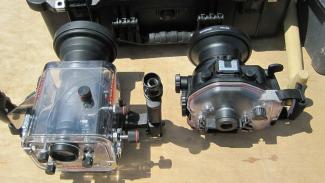
Jakob Owens
Do you struggle to know your arm from your socket, your port from your bracket, your flash from your fisheye and your light from your lens?
Well, you're not alone. Underwater photography has it's own dictionary of parts, accessories & technical terms and it's tough to sound like an expert.
So before you head out and start to talk shop, brush up on your technical knowledge with our interactive guide to underwater cameras and accessories...

The Lowdown
Underwater Housing
The housing is the centrepiece of your underwater photography kit. Usually, each camera or range of cameras has its own underwater housing, allowing you to access all the controls you need underwater. There are a wide range of housings available on the market now, from simple housings made by the camera manufacturer to hi-tech housings costing thousands and lasting a lifetime.
Housings for compact cameras and DSLRs are a little different in design. For comact cameras, the housing is one, fully enclosed unit including a lens port. For DSLR housings, the housing is usually sold without a lens port (think of the lens port as a mini-housing for the camera lens), as a different lens port is needed to accommodate the many different lenses available for DSLR cameras. Some popular brands of underwater housing include Ikelite, Sea&Sea, Nexus, Hugyfot & Patima.
Dome Port
A dome port fits to the front of an DLSR housing, allowing you to use a wide angle lens on the camera. A wide angle lens is a huge bonus in underwater photography as it allows you to get closer to your subject while still fitting it in the frame, which results in a much better image. The dome port you need depends on two factors - the housing you have and the camera lens you want to use.
Macro Port
Just like a dome port, a macro port fits to the front of a DLSR housing and allows you to use a macro lens underwater to get crisp, sharp shots of all those crazy critters. It is possible to get a range of macro lens with differenct levels of magnification.
Mount Base
If you just have a compact camera, it is still possible to attach wide angle and macro lenses to the camera to get better shots. Most compact camera housings require a mount base, which attaches to the lens port on your housing. This not only makes the lens port stronger and able to hold a lens, but also has the correct fitting to keep the lenses in place. If you go for this set-up, then you will also need to buy a 'wet lens' - a lens that attaches to the outside of the housing (and therefore gets wet). Before you buy your wet lens & mount base for your compact camera, it's important to check that they use the same size fitting, otherwise you are wasting your money. Popular brands of wet lens are Inon, Epoque & Ikelite.
Strobe
A strobe acts as your flashlight underwater. They can make a huge difference to the quality of your image and should be at the top of your list of accessories to buy. Strobes do two things that you standard camera flash can't do.
Firstly, they help to get rid of backscatter. Standard camera flashes fire in exactly the same direction as your lens and reflect off particles in the water, creating backscatter. Strobes get round this problem by allowing you to use fire the flash from above or at an angle, meaning less backscatter (and sometimes none at all). Secondly, they can provide a more powerful flash that covers a wider angle, meaning that your photo will be better lit.
For compact cameras, strobes usually copy the cameras standard flash or require you to set the strenngth of the light manually. For DSLR's, they usually connect via the camera's hotshoe and are triggered directly from the camera. Most underwater photographers are happy with one strobe, but more serious photographers may opt for two strobes, which provide both more light and more options. Popular brands of strobe are Inon, Sea&Sea, Epoque & Ikelite.
Arms & Trays
To connect your underwater housing to your strobe, you will need an arm, a tray and sometimes even a handle. These accessories are pretty straight forward and fit together in a way that allows you to position that strobe as you wish, while keeping your hands free to take the picture. Some arms also allow you to attach wet lenses or other accessories to them for handy storage. Most retailers sell strobes together as a package with the arms, trays and handles you will need. If you want to do very wide angle photography, then you may need a longer arm, which will allow you to position the strobe further away from the camera and light a wider area. Likewise, if you want to do macro photography, a shorter arm may prove more useful.
O-rings & O-ring Grease
Underwater housings have many parts that are moveable, or that open completely. These areas need to be sealed so that water does not enter. This is done with rubber o-rings - a small, circular piece of rubber that creates an effective seal. O-rings come in many sizes and any underwater housing will have many o-rings. More expensive housings are likely to have stronger, thicker o-rings and may even have two o-rings for double protection.
These o-rings need to be cleaned and maintained regularly as a dirty or faulty o-ring is the main reason for a housing to flood. They also need to be greased, which halps to maintain their longevity and helps them to provide a perfect seal. As each manufacturer makes o-rings from a slightly different type of rubber, you should only use the o-ring grease that they recommend. It is a good idea to have at least one spare main o-ring with you when diving.

Wessex Archaeology
You might also enjoy...
Kimbe Bay
Kimbe Bay is on the island of New Britain, a large island running east to west that separates the Solomon Sea to the south from the Bismark Sea to the north.
The area is known for its stunning coral formations and boasts a huge diversity of marine life, from Dolphins, Sharks and Whales to endless tiny invertebrates.
Anilao
Diving in Anilao is a popular activity in part due to its proximity to Manila. However, little Anilao is a match for many top diving areas in the Philippines.
While there are colourful reefs to enjoy, diving in Anilao is especially known for smaller marine life, most notably nudibranchs. It is also very popular for underwater photography.
Underwater photography hotspots
Asia is blessed with all the ingredients any budding underwater photographer could ever wish for.
It has an enormous variety of dive sites, incredible diversity, an almost limitless choice of subjects and many highly professional dive centres to choose from.
But where are some of the very best spots for underwater photography & video? Our quick guide gives you the lowdown...
Lankayan
The picturesque island of Lankayan is now regarded as one of Malaysia’s finest dive destinations.
The island, which is just off east the coast of Borneo in the Sulu Sea, has only one resort, ensuring uncrowded dive sites and plenty of relaxation.
Bohol
The island of Bohol lies just to the east of Cebu in the Viasayas region of the Philippines and is a popular island for tourists.
The area's diving is also a major attraction, with great macro life, plentiful turtles and lovely coral reefs. Good diving options are available on the west coast, and also the quieter south-east region of Anda.
Underwater photography etiquette
Tara North







